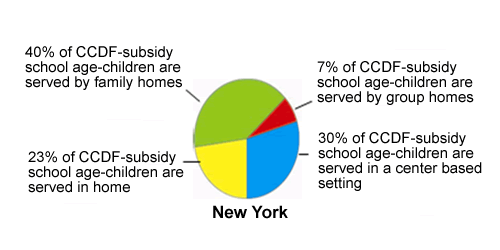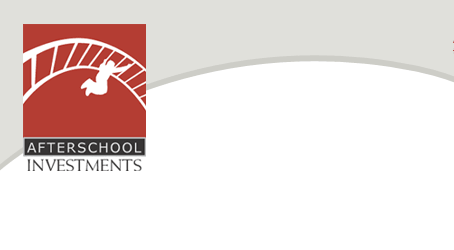|
The Afterschool Investments project has developed profiles for each state to provide a snapshot of the "state of afterschool," as well as an opportunity to compare afterschool activities across the country. This profile provides key data and descriptions of the afterschool landscape, which includes a range of out-of-school time programming that can occur before and after school, on weekends, and during summer months. It is designed to serve as a resource for policymakers, administrators, and providers.
Quick Facts
Demographics
| Total population: |
19,306,183 |
Number of children ages 5-12:
|
1,950,823 |
| Percent of population: |
10.1% |
Percent of students eligible for free and reduced-price lunch:
|
44.2% |
Percent of K-12 students in Title I "Schoolwide" schools:
|
31.7% |
For more demographic information, visit http://nccic.acf.hhs.gov/statedata/statepro/index.html
Child Care and Development Fund (CCDF)
• CCDF Administrative Overview
Administering agency: |
Department of Family Assistance,
Bureau of Early Childhood Services, Office of Children and Family Services |
Total FFY06 federal and state CCDF funds: |
$520,038,947 |
FFY06 total federal share: |
$313,751,516 |
FFY06 state MOE plus match: |
$206,287,431 |
FFY06 School Age & Resource and Referral Targeted Funds: |
$933,744 |
FFY06 Tribal CCDF Allocation:
|
$704,790 |
FFY05 Total Quality Expenditures: |
$85,796,269 |
Percent of children receiving CCDF subsidies who are ages
5-12: |
51.7% |
• Settings

Where CCDF-Subsidy school age-children are served:
| In a center based setting |
30% |
| By group homes |
7% |
| By family homes |
40% |
| In home |
23% |
• Uses of CCDF Targeted Funds and Quality Dollars for Afterschool
"Resource and referral and school-age" targeted funds:
New York has a special School Age
Credential developed by a team that
included the state Office of Children
and Family Services, Cornell University, and the New York School Age Care Alliance.
Other quality activities:
Funds may support school-age child
care provider training and tuition
remission for licensed school-age
providers.
• Provider Reimbursement Rates
Label assigned by state for school-age rate category: |
6-12 years |
Maximum rate for center-based school-age category: |
$34.00/day |
Notes: Rates vary by groups of
counties. Rates for Bronx, Kings,
Manhattan, Queens, and Richmond
counties given. |
Standardized monthly center-based school-age rate: |
$480 |
Are separate subsidy rates offered for part-time and full-time care? |
No |
Temporary Assistance for Needy Families (TANF) and Child Care
FFY05 state TANF transfer to CCDF: |
$381,791,205 |
FFY05 TANF direct spending on child care:
|
$0 |
Program Licensing and Accreditation Policies
| Are there separate licensing standards governing the care of school-age children? |
Yes |
Are there specialized requirements for center-based care for school-age children? |
Yes |
Ratio of children to adults in school-age centers: |
5 years 9:1; 6-9 years 10:1, 10 years and over 15:1 |
Number of National AfterSchool Association (NAA) accredited programs:
|
18 |
21st Century Community Learning Centers (21st CCLC)
FY06 state formula grant amount: |
$90,478,377 |
Most recent competition: |
January 2005 |
Applications funded: |
88 |
Total first year grant awards: |
$21,022,871 |
| Fiscal agent type: |
39.8% school district
60.2% other |
| Licensing required? |
Yes, for certain types of programs. |
Return to top
Statewide Initiatives
-
The After-School Corporation (TASC). TASC works to increase the availability and quality of afterschool programs in New York. While the main thrust of TASC’s efforts has been in New York City, its policy development work and a growing focus of core services is focused on statewide activities. TASC was established in 1998 with funds from the Open Society Institute "to enhance the quality, availability, and sustainability of afterschool programs in New York City and across the state." TASC funds programs and also provides them with training and technical assistance in a variety of areas, including programming and organizational capacity. TASC documents and disseminates information on promising practices in afterschool through the Promising Practices in After-School Programs Initiative. To date, TASC has awarded 35 Promising Practices Awards in New York. In 2003, New York City Mayor Bloomberg, along with the Open Society Institute, announced a combined $30 million in support of TASC and afterschool programs in New York City.
For more information, see http://www.tascorp.org.
-
Statewide Afterschool Network. The New York State Afterschool Network (NYSAN) is a public-private partnership of statewide, regional, and local groups dedicated to promoting young people's safety, learning, and healthy development outside the traditional classroom. NYSAN's activities are directed toward building the capacity and commitment of communities to increase the quality and availability of programs during non-school hours. NYSAN's statewide partners include The After-School Corporation, Association of New York State Youth Bureaus, Children's Aid Society, Coalition for After-School Funding, Cornell University: The Cornell Early Childhood Program and Cornell Cooperative Extension, New York City Department of Education, New York State Center for School Safety, New York State Education Department, New York State Office of Children and Family Services, New York State School Age Care Coalition, Partnership for After School Education, and United Way of New York State.
For more information, see http://www.nysan.org
-
State-Administered Programs. In 1999, the State Office of Children and Family Services developed the Advantage After School Program, which funds community-based organizations working in partnership with local schools to expand youth development-focused activities during non-school hours. If programs are selected for funding by Advantage and TASC, TASC will provide $1 for every $3 of combined state and local match. Another state program, the Extended School Day/Violence Prevention Program of the State Education Department has been supporting similar projects since 1996, providing competitive grants for collaborative projects between schools and community-based partners.
For more information, see http://www.ocfs.state.ny.us/main/Youth
-
Legislative Resolutions for Afterschool Care. In June 2003, two legislative resolutions were passed related to afterschool programming in the state of New York. Senate Resolution 2328 proclaimed October 9, 2003, as Quality After-School Program Day and Assembly Resolution 1033 proclaimed that the state of New York commits to make quality afterschool programs available to every child in New York state by the year 2010.
Return to top
Notable Local Initiatives
-
New York City Beacons Initiative. The Beacons Initiative began in 1991 to address the lack of constructive afterschool activities through school-based programming that involves a wide range of community partners. The New York City Department of Youth and Community Development manages and provides funding for the initiative, which has grown to 90 sites. Other large funders include the Fund for the City of New York, The Annie E. Casey Foundation, the Charles Hayden Foundation, the Open Society Institute, and J. P. Morgan. Thanks to continued positive results, the Wallace Foundation provided resources and technical assistance to replicate the Beacons model in Oakland, Savannah, Denver, Minneapolis, and San Francisco.
-
Partnership for After School Education (PASE). PASE was formed in 1993 in New York City as a professional network for afterschool providers committed to the fields of youth development and afterschool education. PASE provides support to afterschool programs throughout the city by providing opportunities for staff development and training, mentoring, resource sharing, and networking. PASE is also committed to increasing the visibility of the afterschool field and advocating for increased resources and support. In 1999, PASE developed its first Afterschool Learning Lab in two school sites in the city. Practitioners from across the city are selected through a competitive process to showcase their most effective programs at the Lab. The Lab provides a venue for afterschool providers and policymakers to observe innovative programming and to discuss promising practices. With a grant from the Annenberg Foundation, PASE is piloting an expanded version of the Labs nationally.
Return to top
Statewide Organizations
National AfterSchool Association Affiliate:
New York State School-Age Care Alliance (NYSSACA)
230 Washington Ave Extension
Albany, NY 12203
Phone: 518-694-0660
Email: mail@nyssacc.org
Web: www.nyssacc.org
Statewide Child Care Resource & Referral Network:
New York State Child Care Coordinating Council, Inc
230 Washington Avenue Extension
Albany, NY 12203
Phone: 518-690-4217
Fax: 518-690-2887
Statewide Afterschool Network:
New York State Afterschool Network
925 Ninth Avenue
New York, NY 10019
Phone: 718-755-7780
Web: www.nysan.org
Return to top
Additional Resources
State Child Care Administrators:
http://nccic.acf.hhs.gov/statedata/dirs/display.cfm?title=ccdf
State TANF Contacts:
http://www.acf.hhs.gov/programs/ofa/tanf-dir.htm
21st Century Community Learning Centers Contacts:
http://www.ed.gov/programs/21stcclc/contacts.html
Return to top
Notes and Sources
Demographics
Total population: Annual Estimates of the Population for the United States and States, and for Puerto Rico: April 1, 2000 to July 1, 2006, U.S. Census Bureau.
Number of children ages 5-12: Estimates of the Resident Population by Single-Year of Age and Sex for the United States and States: July 1, 2006, U.S. Census Bureau.
Percent of students eligible for free and reduced-price lunch rate: Numbers and Types of Public Elementary and Secondary Schools from the Common Core of Data: School Year 2005-06. U.S. Department of Education. Washington, DC: National Center for Education Statistics.
Percent of K-12 students in Title I "schoolwide" schools: Numbers and Types of Public Elementary and Secondary Schools from the Common Core of Data: School Year 2005-06. U.S. Department of Education. Washington, DC: National Center for Education Statistics. The federal Title I program provides funding to local school districts and schools with high percentages of poor children to help ensure that all children meet challenging state academic content and student academic achievement standards. Schools enrolling at least 40 percent of students from poor families are eligible to use Title I funds for schoolwide programs that serve all children in the school.
Child Care and Development Fund
The Child Care and Development Fund (CCDF) is the largest federal funding source for child care. States receive a funding allocation determined by formula and have broad flexibility to design programs that provide child care subsidies for low-income children under the age of 13 and to enhance the quality of child care for all children. Federal CCDF funding consists of mandatory, matching, and discretionary funds. Federal law requires that states spend at least 4 percent of their CCDF funds as well as additional targeted funds on activities to improve the quality and availability of child care. CCDF administrative data in this and the following sections is from the U.S. Department of Health & Human Services, Administration for Children and Families, Child Care Bureau, as reported by States, unless otherwise noted.
FFY06 state MOE plus match: In order to receive Federal matching funds, a state must expend Maintenance of Effort funds. Note that this does not capture actual expenditures, only the minimum required to draw down all available federal funds.
FFY06 Tribal CCDF Allocation: Federal CCDF Funds are awarded directly to Federally-recognized Indian Tribes.
FFY05 total quality expenditures: This data includes FY05 and prior year funds expended for quality from each of the CCDF funding streams (mandatory, matching, and discretionary) and expenditures under targeted funds for infant and toddler, school-age care and resource and referral. This figure provides information obtained from state financial reports submitted for FY05.
Uses of CCDF Targeted Funds and Quality Dollars for Afterschool: Portions of CCDF discretionary funds are targeted specifically for resource and referral and school-age child care activities as well as for quality expansion. (These funds are in addition to the required 4 percent minimum quality expenditure.)
Maximum rate for school-age category: Rate listed applies to center-based care; where rates vary by region or county, the rate for the most populated urban area is given.
Standardized monthly school-age rate: Monthly rate for a child, age 8, in care after school during the school year at a center in the most costly district for four hours per day, 20 days per month. Calculated (in the lowest tier of a tiered system) using information from the FY2006-2007. State CCDF Plan, including rate structures, as submitted to the U.S. Department of Health & Human Services, Administration for Children and Families.
Separate subsidy rates for part-time vs. full time and Tiered Reimbursement Rate Systems: U.S. Department of Health and Human Services. Child Care Bureau. Report of State Plans FY2006-2007.
Temporary Assistance for Needy Families (TANF) and Child Care
In addition to spending TANF funds directly on child care, a state may transfer up to 30 percent of its TANF grant to CCDF. Expenditures represent TANF funds spent in FY05 that were awarded in FY05 and prior years. Data from the U.S. Department of Health and Human Services, Administration for Children and Families.
Program Licensing and Accreditation Policies
States with separate school-age licensing standards and states with specialized requirements for child care centers serving school-age children: National Association for Regulatory Administration, 2005 Child Care Licensing Study, available at http://www.nara.affiniscape.com/displaycommon.cfm?an=1&subarticlenbr=104.
Ratio of children to adults in school-age setting: Data from the National Child Care Information Center (NCCIC), available at: http://nccic.acf.hhs.gov.
Number of NAA-accredited programs: Data from the National AfterSchool Association, March 2007, available at: http://www.naaweb.org.
21st Century Community Learning Centers
The No Child Left Behind Act of 2001 converted the 21st Century Community Learning Centers’ authority to a state formula grant. In past years, the U.S. Department of Education made competitive awards directly to school districts. Under the reauthorized law, funds flow to states based on their share of Title I, Part A funds. States use their allocations to make competitive awards to eligible entities. Data from the U.S. Department of Education 21st Century Community Learning Centers Office and the 21st CCLC Profile and Performance Information Collection System.
Return to top
The Child Care Bureau awarded a technical assistance contract to The Finance Project and their partner, the National Governors Association Center for Best Practices, for the Afterschool Investments project. The goals of the Afterschool Investments project include:
- Identifying ways that state and communities are using Child Care and Development Fund (CCDF) subsidy and quality dollars to support out-of-school time programs, and sharing these practices and approaches with other states;
- Identifying administrative and implementation issues related to CCDF investments in out-of-school time programs, and providing information and context (about barriers, problems, opportunities) as well as practical tools that will help CCDF administrators make decisions; and
- Identifying other major programs and sectors that are potential partners for CCDF in supporting out-of-school time programs and providing models, strategies, and tools for coordination with other programs and sectors.
Contact Us:
Email:
afterschool@financeproject.org
Web:
http://nccic.acf.hhs.gov/afterschool/
The Finance Project
1401 New York Avenue, NW
Suite 800
Washington, DC 20005
Phone: 202-587-1000
Web: www.financeproject.org
National Governors Association
Center for Best Practices
444 North Capitol Street, NW
Washington, DC 20001
Phone: 202-624-5300
Web: www.nga.org
The Afterschool Investments project’s State Profiles are designed to provide a comprehensive overview of noteworthy State and local initiatives across the country. Inclusion of an initiative in the Profiles does not represent an endorsement of a particular policy or practice.
|





